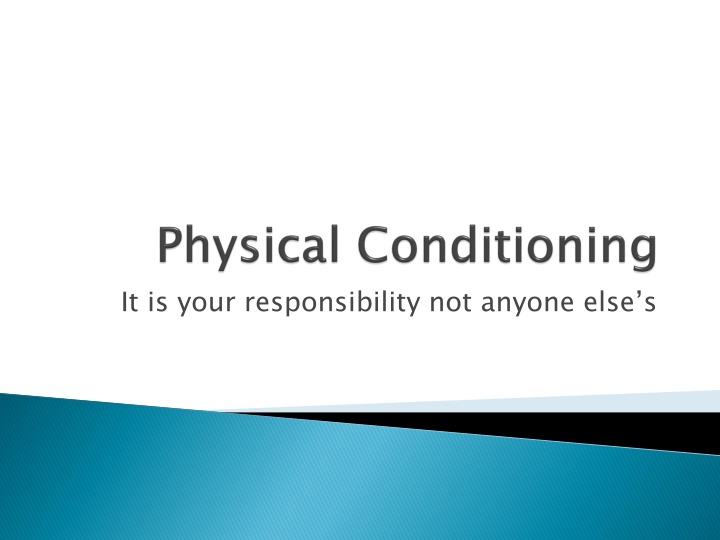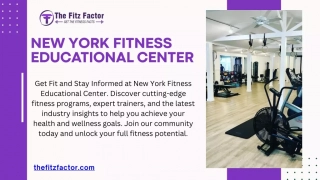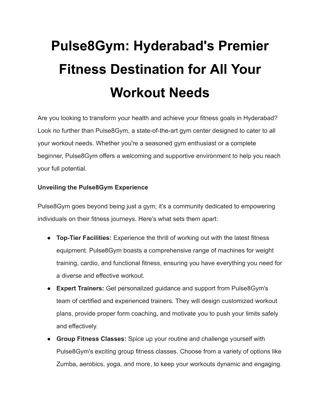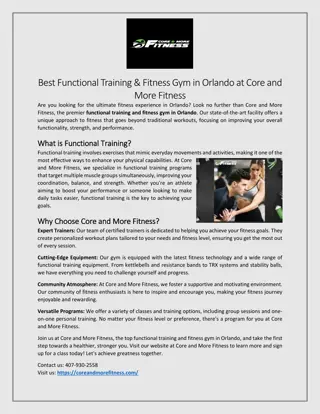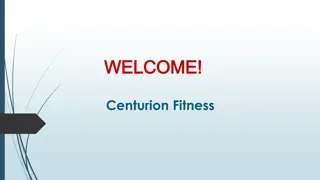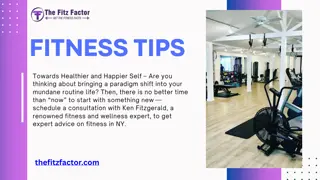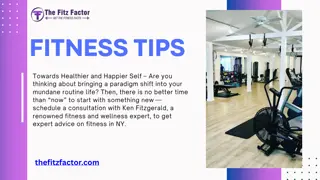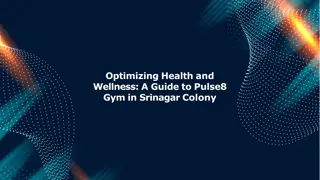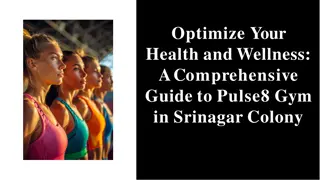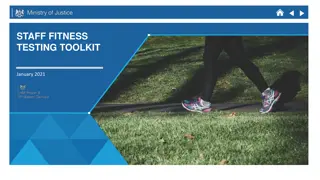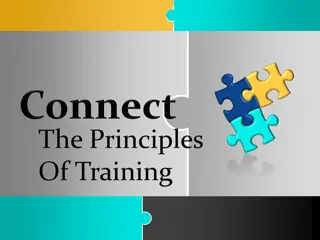Achieving Your Fitness Goals: Tips and Principles to Follow
Explore the key principles of fitness, including individual differences, overload, progression, adaptation, use/disuse, and specificity. Learn about the importance of warm-ups, physical exercises, and cool-downs in a workout routine. Discover specific activities like cardio, strength training, martial arts, and outdoor sports to enhance your fitness journey. Get insights into meeting training standards and maintaining fitness goals through consistent practice and healthy habits.
Download Presentation

Please find below an Image/Link to download the presentation.
The content on the website is provided AS IS for your information and personal use only. It may not be sold, licensed, or shared on other websites without obtaining consent from the author.If you encounter any issues during the download, it is possible that the publisher has removed the file from their server.
You are allowed to download the files provided on this website for personal or commercial use, subject to the condition that they are used lawfully. All files are the property of their respective owners.
The content on the website is provided AS IS for your information and personal use only. It may not be sold, licensed, or shared on other websites without obtaining consent from the author.
E N D
Presentation Transcript
A. The Principle or Individual Differences B. The Principle of Overload C. The Principle of Progression D. The Principle or Adaptation E. The Principle of use/ Disuse F. The Principle of Specificity
A. The Warm Up ( Consisting of Stretches) B. The Session consisting of physical exercise. C.The cool down which will be approximately 15 to 20 minutes after completion of physical exercise.
1. You will run 1.5 miles for cardio several times 2. You will do a minimum of 20 push ups for upper body strength 3. You will do a 14 minimum vertical jump. 4. We will do the 300 meter run in 74 seconds for time 5. We will do the Agility run in 20.4 seconds time
1. Weight Training 2. Martial art s training 3. Cycling ,Out door sports 4. Basketball 5. Or just walking. Weather outside or on a tread mill in your home or at the gym. 6. Anything outside of your normal daily activity for at least 30 minutes.
1.Peace Officers Standards and Training have set forth standards. 2.They have a minimum Standard 3.They have a entry level standard that all trainees must meet before graduation. 4.If you don t meet the minimum standard you will be released from the academy. 5.If you meet the entry level standard you must maintain it through out the academy.
1.There are several way to achieve this goal. 2.Run and practice every day 3.Go up to a higher elevation and run and practice. 4.Get a group of you on the weekends and go run great motivation tool. 5.Run up hill weather it s a road or a mountain trail this will help you with cardio and to become more fit.
1.Eating habits 2.Stress 3.Drinking 4.Drug s use prescription or illegal.
1. Depending on how much is taken and the physical condition of the individual, Alcohol can cause A. Slurred speech, B. Drowsiness, C. Vomiting
1. Binge drinking and continued alcohol use in large amounts are associated with many health problems, including: A. Unintentional injuries such as car crash, B. falls, C. burns, D. drowning.
Category Examples Examples of General Effects Alcohol beer, wine, spirits impaired judgement, slowed reflexes, impaired motor function, sleepiness or drowsiness, coma, overdose may be fatal Cannabis marijuana, hashish distorted sense of time, impaired memory, impaired coordination Depressants sleeping medicines, sedatives, some tranquilizers inattention, slowed reflexes, depression, impaired balance, drowsiness, coma, overdose may be fatal Hallucinogens LSD (lysergic acid diethylamide), PCP (phencyclidine), mescaline inattention, sensory illusions, hallucinations, disorientation, psychosis Inhalants hydrocarbons, solvents, gasoline intoxication similar to alcohol, dizziness, headache Nicotine cigarettes, chewing tobacco, snuff initial stimulant, later depressant effects Opiates morphine, heroin, codeine, some prescription pain medications loss of interest, "nodding", overdose may be fatal. If used by injection, the sharing of needles may spread Hepatitis B, or C and HIV/AIDS. Stimulants cocaine, amphetamines elevated mood, overactivity, tension/anxiety, rapid heartbeat, constriction of blood vessels
1.There are many known CHD risk factors. You can control some risk factors, but not others. Risk factors you can control include: A. High blood cholesterol and triglyceride (tri- GLIS-er-ide) levels (a type of fat found in the blood) B. High blood pressure C. Diabetes and prediabetes D. Overweight and obesity E. Smoking
1.Although there are no sure-fire recipes for good health, the mixture of healthy eating and regular exercise comes awfully close. 2.Regular exercise or physical activity helps many of the body s systems function better, keeps heart disease, diabetes, and a host of other diseases at bay, and is a key ingredient for losing weight.
1. Calcium A. Why It s Good for You: do your heart and other muscles. Studies have shown a link between getting enough calcium and lower blood pressure, as well as weight control. B. How Much You Need: as you age, according to the Institute of Medicine, the group of experts that sets nutrient quotas. Here's what you need every day: a. Ages 19 to 50: 1,000 milligrams b. Ages 51 and up: 1,200 mg 1. Calcium A. Why It s Good for You: Your bones need it. So B. How Much You Need: You need more calcium
C. How to Get More of It: low-fat dairy foods each day, as part of a balanced diet, provide you with the calcium you need. If you have a dairy allergy or lactose intolerance, you can get calcium from calcium- fortified products, dark green leafy vegetables, nuts, and seeds. C. How to Get More of It: Three servings of
a.Some examples of foods that provide around 300 milligrams of calcium per serving include: b.8 ounces nonfat milk or nonfat plain yogurt c.8 ounces calcium-fortified orange juice d.1 1/2 ounces hard cheese e.8 ounces calcium-fortified soy milk, almond milk, or another milk alternative
2. Fiber A. Why It s Good for You: digestion, lowering cholesterol, and managing blood sugar levels. It's filling, and it's found in foods that are low in calories, so it helps you manage your weight. B. How Much You Need a. Men ages 19 to 50: 38 grams; ages 51 years and older: 30 grams b. Women ages 19 to 50: 25 grams; ages 51 years and older: 21 grams C. How to Get More of It: 2. Fiber A. Why It s Good for You: Fiber is good for your B. How Much You Need: C. How to Get More of It:
a. Include fruits and vegetables and high-fiber whole grains at every meal and beans several times a week. b. Snack on whole-grain crackers, fruit, vegetables, nuts and seeds (including natural- style nut butters) or popcorn (a whole grain) instead of cookies, candy, or chips. c. Choose whole-grain breads and cereals, whole wheat pasta, and other whole grains, such as, barley, cracked wheat, and wild rice.
3. Vitamin A : Essential Nutrient for Eyes A. Why It s Good for You for your vision, genes, immune system, and many other things. B. How Much You Need two forms: as retinol (which is ready for the body to use) and carotenoids, the raw materials the body converts to vitamin A. 3. Vitamin A : Essential Nutrient for Eyes A. Why It s Good for You: You need vitamin A B. How Much You Need: Vitamin A comes in
C. How to Get More of It colorful. Top picks include: a. Carrots b. Sweet potatoes c. Pumpkin d. Spinach C. How to Get More of It: Make your diet
4. Potassium: Essential Nutrient for Nerves and Muscles 4. Potassium: Essential Nutrient for Nerves and Muscles A. Why It s Good for You: in every cell of your body. It plays a key role in maintaining muscles, nerves, and fluid balance. A. Why It s Good for You: Potassium is present
B. How Much You Need: 19 and older need 4,700 milligrams of potassium every day. B. How Much You Need: Men and women age a.If you have high blood pressure, check with your doctor or pharmacist about the medications you take to control it.
C. How to Get More of It: packed foods will help you meet your daily quota: a. 1 cup canned white beans: 1,189 milligrams b. 1 cup cooked spinach: 839 mg c. Medium sweet potato, cooked: 694 mg d.1 cup fat-free yogurt: 579 mg C. How to Get More of It: These potassium-
5. Folic Acid 5. Folic Acid A. Why It s Good for You: you'll become pregnant or are pregnant, this is particularly important. Folic acid is the synthetic form of the B vitamin folate. A. Why It s Good for You: If there's a chance
B.How recommended 400 micrograms of folic acid every day from supplements is a must for women who may become pregnant. B.How Much You Need: Much You Need: Getting the
C. How to Get More of It folic acid supplement, women who could become pregnant should eat folate-rich foods including: a.Breakfast cereals: 1 ounce equals 100-400 micrograms of folic acid b. Enriched spaghetti: 1 cup cooked equals 80 mcg folic acid C. How to Get More of It: In addition to taking a
c. Enriched bread: 2 slices equals 34 mcg folic acid d. Lentils: 1 cup cooked equals 358 mcg folate e. Spinach: 1 cup cooked equals 263 mcg folate
6. Iron A. Why It s Good for You: for transporting oxygen to cells and tissues throughout the body. 6. Iron A. Why It s Good for You: Iron is responsible
B.How per day of iron. Women need 18 milligrams per day from ages 19 to 50 (27 grams if they're pregnant) and 8 milligrams from age 51 on (because they are no longer losing iron through menstruation). B.How Much You Need: Much You Need: Men need 8 milligrams
C. How to Get More of It: iron include: a.3 ounces cooked beef: 3 milligrams b.3 ounces cooked dark-meat turkey: 2 mg c.3 ounces cooked light-meat turkey: 1 mg d.3 ounces cooked chicken thigh: 1.1 mg e.3 ounces cooked chicken breast: 0.9 mg f.1 large hardboiled egg: 0.9 mg C. How to Get More of It: Animal sources of
g. Spinach, raisins, and beans are also good sources of iron. So are whole-grain cereals that have been enriched with iron. Keep in mind that the iron absorption rate from plant sources is lower than with animal sources of iron.
7. Vitamin D A. Why It s Good for You: vitamin D in response to sunlight, but its ability to do that depends on your age, skin color, and where you live 7. Vitamin D A. Why It s Good for You: Your skin makes
B. How Much You Need: recommendations call for adults ages 19-70 to get 600 international units of vitamin D per day, and 800 IU per day starting at age 71. B. How Much You Need: Current
C. How to Get More of It: vitamin D include fish and egg yolk. Vitamin D- fortified foods include milk, yogurt, some orange juice products, and some breakfast cereals. You may need a mixture of both food and supplements to get the vitamin D your body requires. C. How to Get More of It: Natural sources of
1. What is a "Healthy Diet"? A. The Dietary Guidelines for Americans describe a healthy diet as one that: a. Emphasizes fruits, vegetables, whole grains, and fat-free or low-fat milk and milk products; a. Includes lean meats, poultry, fish, beans, eggs, and nuts; and c. Is low in saturated fats, trans fats, cholesterol, salt (sodium), and added sugars. 1. What is a "Healthy Diet"?
B. The recommendations in the Dietary Guidelines and in MyPlate are for the general public over 2 years of age. MyPlate is not a therapeutic diet for any specific health condition.
C. Guidelines to: C. MyPlate Guidelines to: MyPlate helps individuals use the Dietary helps individuals use the Dietary a. Make smart choices from every food group. b. Find balance between food and physical activity. c. Get the most nutrition out of calories. d. Stay within daily calorie needs.
1. Specific A. Goals must call for specific actions, behaviors or events to be successfully met. Individuals must define their desired results within each goal statement using a proactive voice. 1. Specific
2.Measurable A. Goals must be measurable to assure success. When setting goals, it is important to describe how each result will be measured. In our example we set clear steps and timelines. 2.Measurable
B. We set measurable tracking points by establishing a weekly timeline. If goals are not measurable, individuals cannot track their progress.
3. Achievable A.Goals must be achievable. A person cannot become a doctor if he has not been graduated from medical school, nor can a business increase its sales if it does not have an advertising budget. 3. Achievable
B. In a savings-related goal like our example, a person must ask himself whether the goal is achievable with his current resources.
4.Realistic A A. Taking a realistic approach is perhaps one of the most important characteristics of successful goal setting. Goals challenge us to achieve or attain what is important to us. 4.Realistic
B B. In the example goal, if we could not afford to save the $50 dollars a week, then we would face hardship and would not reach our goal by summer.
C C. Realistic goals are honest goals. Goals established thoughtfully can challenge us, but are not set beyond our natural abilities.
5.Timely A. Successful goal setting must set forth measurable points for starting, ending, review and assessment. A successful goal has deadlines and endings. 5.Timely
a. In our example, we set a weekly period goal and an end goal of summer.
1. HYDROMETRY A. Hydrometry is the measurement of the total body water. Most hydrometry techniques utilize a tracer which is diluted in one of the water components. 1. HYDROMETRY
B. Assumptions for hydrometry include: a. Tracer distributed only in body water compartments b. Tracer is equally distributed c. Equlibrium is rapid d. Tracer is not metabolized e. Error: 1% for TBW and 0.5% for FFM
